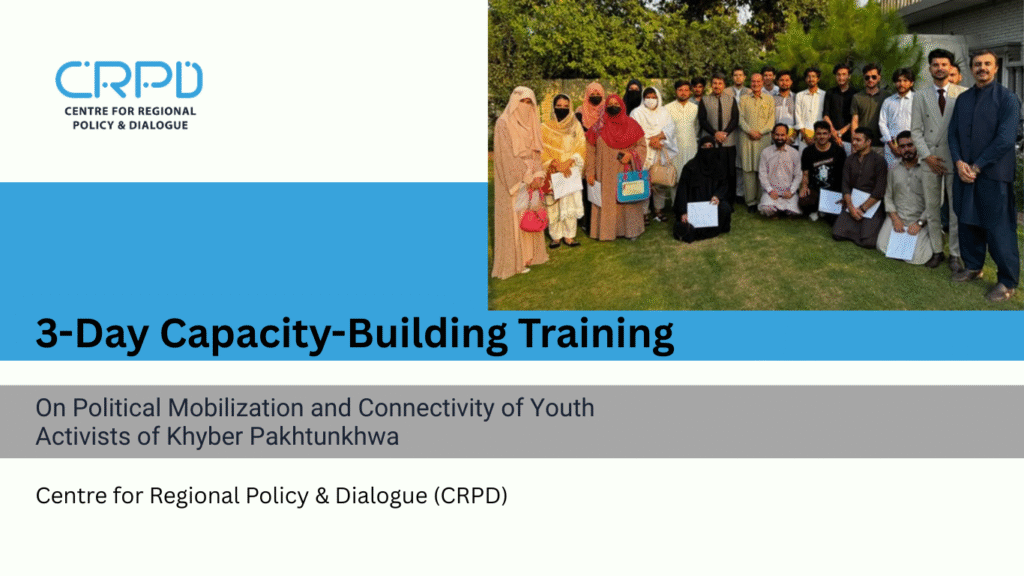Khadim Hussain
23 May 2025
Two significant developments taking place in Central Asia in the past month largely went unnoticed in the information ecology of South Asian region mostly because of the rise in hostilities between India and Pakistan.
The first big news concerns to the restarting of work on the Kabul and the Kandahar corridors through the Trans-Afghan Railway Network, one of the small parts of a mega transportation project. Connecting South Asia, Central Asia, Iran, China, Russia and Eastern Europe through rail, road and sea networks constructing alternative trade routes seems to be a real game changer in geoeconomic, cultural, social and political domains in Central Asia, South Asia, the Middle East, Far East Asia and Eastern Europe. The connecting projects of alternative trade routes conceived almost two decades ago are ratcheted up in the recent years perhaps because of rising tensions in several regions of the world including the Black Sea region. Connecting the regions adjacent to the Caucasus, the Caspian Sea region, the Hindukush-Himalayan regions and the Indian Ocean region through an intricate system of road, rail and sea routes underpins the ultimate objective of the gigantic project with the geostrategic, financial, infrastructural and technical support of Central Asia states, South Asian States, the Russian Federation, Iran, Afghanistan, India, China and some international organisations. The Central Asian states, especially Uzbekistan, seem to be playing a significant strategic role while Afghanistan appears to provide one of the major conduits in bringing the gigantic and intricate system of alternative routes to fruition.
Nargiza Umarov, a research fellow at the Institute for Advanced International Studies (IAIS), University of World Economy and Diplomacy (UWED) and an analyst at the non-governmental research institution Knowledge Caravan (Tashkent, Uzbekistan), informs us in her piece published in The Diplomat on 16 April 2025 that the Russian Ministry of Transport announced on 8 April 2025 that the start of the implementation of the Trans-Afghan Railway would soon be underway as experts of both countries would soon take up preparing feasibility study for the project. As per the ministry’s announcement, two routes have been agreed upon: Mazar-i-Sharif-Herat-Dilaram-Kandahar-Chaman and Termez-Naibabad-Logar-Kharlachi. The latter route is called Kabul Corridor (also Termez-Mazar-i-Sharif-Kabul-Peshawar railway), which was initiated by Uzbekistan in 2018. Several stages of the project have been completed since then but it has also faced several setbacks. Nargiza Umarov is of the view that the emirate in Afghanistan resumed dialogue with Tashkent on the launch of the Kabul Corridor, while simultaneously announcing the construction of the Mazar-i-Sharif-Herat-Kandahar railway (1,468 km), which is presented as the shortest route between Moscow and New Delhi. This, she thinks, would lead to the creation of an alternative rail corridor transiting through the predominantly western Afghan provinces of Farah, Nimroz, Helmand, and Kandahar to reach Pakistani ports on the Indian Ocean. Nargiza informs us that in a recent news report by the Russian Ministry of Transport, the route is mentioned as Mazar-i-Sharif-Herat-Dilaram-Kandahar-Chaman.
The prospects of participation of Turkmenistan in partnership with Kazakhstan in the project is obvious as the Kandahar Corridor is aligned with the Torghundi-Herat-Kandahar-Spin Boldak railway route. Nargiza Umarov further elaborates that in September 2024 Ashgabat began laying the first section of the railway from Torghundi station to Herat as reported by the Diplomat of 16 April 2025. Moscow, according to the Diplomat, has repeatedly expressed interest in constructing both western (from the border of Turkmenistan) and eastern (from the border of Uzbekistan) railways through Afghanistan, seeing in this an opportunity to extend its flagship project, the International North-South Transport Corridor (INSTC), to Pakistan.

Map of the Central Asian Region.
Giving further details of the project, Nargiza Umarov is of the opinion that the route through Kandahar can lead to both Pakistan and Iran. She notes that since 2020, Iran has been constructing the Chabahar-Zahedan railway line, which it plans to extend to the border province of Nimroz in Afghanistan, and from there to Dilaram and Kandahar. This will provide Iran with another outlet to Central Asia via Afghanistan in addition to the Khaf-Herat railway and the transit route through Turkmenistan, she observes. This is of great interest to India, which is actively involved in the modernization of Iranian road infrastructure and the deep-water port of Chabahar if Uzbekistan reorients to the Mazar-i-Sharif-Herat-Dilaram-Kandahar-Chaman railway, the Indian route to Central Asia will become even more realistic, the Diplomat reports.

Map of the South Asian Region.
The Kazakhstan-based The Astana Times in its story of 26 April 2025 reports while quoting Deputy Prime Minister Serik Zhumangarin that Kazakhstan was ready to engage in projects for the development of the trans-Afghan corridor. The report informs us that Kazakhstan was prepared to participate in constructing the Termez-Mazar-i-Sharif -Kabul-Peshawar, and Herat-Kandahar-Spin Boldak railways. The project is expected to reduce the delivery time of goods between the countries by nearly ten times and decrease cargo transportation costs. In this regard, a pilot project, organized with Kazakhstan Temir Zholy Express, was launched on April 24 to establish a new multimodal export route from Kazakhstan through Uzbekistan, Afghanistan, and Pakistan and onward by sea to the port of Jebel Ali in the United Arab Emirates. The expected delivery time of goods to their destination is 20-25 days. With the construction of trans-Afghan railways, cargo will go from China through Kazakhstan to the west and Afghanistan towards Pakistan and India, the report by The Asthana Times says.
In The Gulf Observer and Pakistan Today of 17 April 2025 under the title of ‘Uzbekistan expands International Transport Routes’, Saidkamol Sultonbekov, a lead Specialist of Center for Transport and Logistics Development Ministry of Transport of the Republic of Uzbekistan, provides salient features of the transport network that would link East Asia with South Asia, and the Middle East with the Caucasus and Europe through a sustainable transport network with Uzbekistan playing the role of a strategic focal point. The countries of Central Asia and the Caucasus, he observes, are undergoing dynamic development as the rapidly evolving global geopolitical landscape underscores the urgent need for comprehensive, coordinated efforts to modernize transport systems and diversify trade routes.

Map of the Caucasus Region.
Saidkamol Sultonbekov thinks that the recent tensions in the Red Sea and Eastern Europe have intensified the demand for secure, stable, and mutually beneficial transport corridors between Europe, China, and Central Asia. He further details that the Trans-Caspian International Transport Corridor—also known as the Middle Corridor—has attracted significant global attention as an alternative route connecting China, the Middle East, and Central Asia with Europe. Saidkamol Sultonbekov apprises us that Uzbekistan actively collaborates with the European Union to develop both new and existing international corridors. The country, he observes, is a participant in the CASCA+ multimodal corridor (linking Asia-Pacific countries, China, Kyrgyzstan, Uzbekistan, Turkmenistan, Azerbaijan, Georgia, Turkey, and Europe), with the Middle Corridor forming its backbone.
Saidkamol Sultonbekov informs us that a major milestone in this cooperation was the five-party agreement signed in Tashkent on December 20, 2019, involving railway authorities of Azerbaijan, Georgia, Kyrgyzstan, Turkmenistan, and Uzbekistan. Turkey joined the initiative, he informs us, in December 2021, marking the signing of a six-party protocol. The agreement, he thinks, outlines preferential tariff policies, unified freight transportation regulations, logistics coordination, and improved customs procedures, including a pre-notification system and logistics hub development across transit nations. Saidkamol Sultonbekov is of the opinion that among various routing options, the path from China through Kyrgyzstan, Uzbekistan, Turkmenistan, Azerbaijan, Georgia, and Turkey to Europe stands out as the shortest (4,917 km) between China and Europe which, he thinks, aligns with the EU’s “Global Gateway” investment strategy, being implemented in collaboration with Kazakhstan, Kyrgyzstan, Tajikistan, Turkmenistan, the South Caucasus, and Turkey. Recognizing the need for diversified transport options, he observes, Uzbekistan is also actively promoting the development of the China-Kyrgyzstan-Uzbekistan-Turkmenistan-Iran-Turkey corridor (5,430 km). This rail corridor, extending from Kashghar (China) to Istanbul (Turkey), enables multimodal freight transport across rail, road, and sea, with onward connections to Europe and the Black Sea, Saidkamol Sultonbekov concludes.

Map of the Caspian Sea Region.
Giving details of implementation, Saidkamol Sultonbekov reports that on 1st Nov 2023, in the framework of the Economic Cooperation Organization (ECO), transport ministers from Uzbekistan, Turkmenistan, Iran, and Turkey signed a protocol to develop this corridor. Each participating country, he informs us, committed to designating a rail operator for container freight, conducting pilot runs, and providing tariff concessions. He divulges that talks are underway to include China, Kyrgyzstan, and Tajikistan in the agreement. Moreover, the construction of the China-Kyrgyzstan-Uzbekistan railway, often hailed as the “project of the century,” is expected to enhance the attractiveness of overland freight between China and Europe, he observes. The line will reduce the distance to Europe by 900 km and cut delivery times by seven to eight days, effectively reviving the ancient Silk Road. The development of multiple international corridors between Uzbekistan and the EU will not only strengthen transport links but also boost trade, economic indicators, and living standards across the region, Saidkamol Sultonbekov thinks.
Reference to the revival of the ancient Silk Route is of great significance in the context of the so called ‘globalisation’ mantra. Various regions of the world were connected through land and sea trade routes for several hundred years since the first century AD. Percy Sykes in his two-volumes seminal work A History of Afghanistan, published by Macmillan, London, in 1940, provides exact details of the route in considerable details.
On page 122 of this seminal work, Percy Sykes describes that the principal article of export from China was silk and that there is now a fairly accurate information of the route followed by the camel caravans on this long journey to India and to Europe. Crossing the great desert of Gobi (desert and semidesert region of Central Asia, stretches across huge portions of both southern Mongolia and northern China), and entering Chinese Turkistan at Lopnor (Lop Nur, former saline lake in northwestern China that is now a salt-encrusted lake bed. It lies within the Tarim Basin of the eastern Takla Makan Desert, in the Uygur Autonomous Region of Xinjiang, and is one of the most barren areas of China), the caravans passed through Khotan (Hotan, oasis town, southwestern Uygur Autonomous Region of Xinjiang, far western China), Yarkant (Yarkant, oasis city, southwestern Uygur Autonomous Region of Xinjiang, far western China) and Kashghar (oasis city, western Uygur Autonomous Region of Xinjiang, far western China) to Irkeshtam (Erkeshtam, called Irkeshtam in Chinese and Dungan, or Erkech-Tam in Uyghur and Kyrgyz, is a border crossing between Kyrgyzstan and Xinjiang, China, named after a village on the Kyrgyz side of the border in southern Osh Region) whence, keeping to the north of the main massif of the Pamirs the natural thoroughfare of the Alai trough, was continued by the valley of the Kizil to the Oxus at Termez (city in Uzbekistan, and a port of the Amu Darya {the Oxus River} on the frontier of Afghanistan). From neighbouring Balkh, the rugged passes of the Hindu Kush were crossed to Peshawar, where silk destined for the Roman Empire was carried down the Indus to the port of Barygaza (the modern-day Bharuch in Gujarat state of India was a bustling port, an important hub for India’s trade with Greeks, Romans, Egyptians, and Chinese). A second main route to the west, from Irkeshtam, crossed the Tian Shan pass to fertile Ferghana. It then passed through Samarkand, Merv, Hamadan and Seleucia to the Roman frontier at Zeugma on the Irkeshtam Euphrates, and so to Antioch.
An interesting angle of the alternative trade and transport routes connecting Central Asia, South Asia, the Middle East, Eastern Europe, China and Russia is the connectivity of Iran and China on the model of the Silk Route. This angle has been elaborated by Nargiza Umarova, Senior Research Fellow at the Institute for Advanced International Studies at the University of World Economy and Diplomacy in Tashkent, on Bourse & Bazar Web page on 05 May 2025. Nargiza is of the view that Iran, which remains the primary conduit linking Central Asia to the warm waters of the Indian Ocean, and, by extension, to global trade, is seeking stronger transport links with Afghanistan. Tehran is planning, Nargiza thinks, to launch two railway connections to Afghanistan simultaneously: the Khaf–Herat line in the north and the Zahedan–Zaranj line in the south-west. The railway from Khaf to Herat is nearly complete, she informs us, and the Taliban intend to extend it to Mazar-i-Sharif, a key Afghan trade hub already connected to the Uzbek-built Hairatan–Mazar-i-Sharif railway (launched in 2011) and the planned Kabul Corridor. Integrating these routes could eventually allow Iran, she observes, to reach the Wakhan Valley in Afghanistan’s Badakhshan province, which is the narrow strip of land separating Afghanistan from China.
Nargiza Umarov notes that despite limited progress on this route, Tehran appears unlikely to back down, particularly as it pursues other ambitious projects. One of these is the proposed Iran-Afghanistan-Tajikistan-Kyrgyzstan-China railway corridor, also known as the Five Nation Road, she says. She writes that the initial section will be the Khaf-Herat railway, scheduled to begin full operations later this year. The route would continue through Sheberghan, Mazar-i-Sharif, Khulm, and Kunduz, ultimately reaching the Tajik border at the Sherkhan Bandar crossing, Nargiza informs us. It would then stretch eastwards across Central Asia to Kashghar in western China, spanning an estimated 2,000 kilometers, she notes. In this context, the Taliban’s proposed Mazar-i-Sharif–Herat railway becomes a strategic segment of a broader transit route from Iran to China.
It is also important to mention Termez Dialogue in this regard launched by Uzbekistan for discussing connectivity between Central and South Asia. The inaugural meeting of this dialogue platform was held on May 19-21 at the Termez International Trade Centre, located on the border with Afghanistan. The event will bring together political, economic and business representatives, financial institutions, international and regional organisations, as well as analytical and research centres from around the world as was announced by Nargiza Umarova, Senior Research Fellow at the Institute for Advanced International Studies, University of World Economy and Diplomacy, Tashkent Uzbekistan, on her social media accounts.
The second big news that largely went unnoticed as the information ecology in South Asia was mostly occupied by conflict, strikes and counter strikes and fake news during the friction between India and Pakistan. A former Foreign Minister of Uzbekistan and former Secretary General of Shanghai Cooperation Organisation (SCO), Vladimir Norov, announced on his LinkedIn account on 16 May 2025 that Strategic Energy Diplomacy was in action in Central Asia as Afghanistan joined CASA-1000 talks in Dushanbe. He reported that a high-level Afghan delegation led by Dr. Abdul Bari Omar, CEO of Da Afghanistan Breshna Sherkat (DABS), visited Dushanbe, Tajikistan to participate in a pivotal regional meeting on the CASA-1000 energy project—a major step towards greater energy interconnectivity between Central Asia and South Asia. The meeting brought together key stakeholders from Tajikistan, Kyrgyzstan, Afghanistan, Pakistan, and international partners including the World Bank and the Islamic Development Bank. The focus was evaluating progress, overcoming obstacles, and reaffirming commitments to this ambitious cross-border transmission initiative. CASA-1000, Vladimir Norov thinks, is not just as an energy project, but as a regional trust-building mechanism. CASA-1000 remains one of the few large-scale multilateral infrastructure projects that involve Afghanistan in a constructive, regionally integrated role, he concludes.
Confirming the news of the Strategic Energy Diplomacy, Afghan International of 15 May 2025 reported that Abdul Bari Omar, head of Taliban’s national electricity company, Breshna, met with Daler Juma, Tajikistan’s Minister of Energy, during a visit to Dushanbe to attend a regional summit on the CASA-1000 energy project. Omar and his delegation arrived in Dushanbe in the first week of May 2025, to participate in high-level meetings on CASA-1000, a major electricity transmission project connecting Central and South Asia via Afghanistan, The Afghan International reports. Representatives from Tajikistan, Kyrgyzstan, Pakistan, and Afghanistan, along with other stakeholders also attended the summit. According to Breshna, the summit’s agenda included reviewing the current status of the project, addressing implementation challenges, and drafting a roadmap for future progress. The company reaffirmed its commitment to ensuring the project’s timely completion and operational launch.
The World Bank and Asia Bank supported Turkmenistan-Afghanistan-Pakistan-India Natural Gas Pipeline Project (TAPI) and Central Asia South Asia Electricity Transmission and Trade Project (CASA-1000) initiatives might unleash developmental potentials in the whole of South and Central Asian regions. A study conducted by Syed Masood Sadat entitled ‘TAPI and CASA-1000: Win-Win Trade between Central Asia and South Asia’ and published by Norwegian Institute of International Affairs states that “TAPI natural gas pipeline and the CASA-1000 electricity transmission line, slated to export gas from Turkmenistan, and electricity from Tajikistan and Kyrgyzstan, to India, Pakistan and Afghanistan, respectively” would unleash development in the region. The study finds out that the CASA-1000 was expected to begin operation in 2015, while TAPI was scheduled to ship gas by 2017. None of these objectives has so far been achieved but the renewed enthusiasm and the commitment of the countries in the region to facilitate completion of the project CASA-1000 has rekindled the hope of its operation in the near future.
The connectivity of various regions of the world through alternative and diverse rail, road and sea routes pivoting Central Asia, and the integration of South and Central Asia would not only unleash developmental and trade potential of the regions but would also build bridges through cultural, intellectual and political exchange between the various regions and countries of various regions. Untethering of this immense potential requires will power, commitment, technical expertise, pooling up resources and innovative frameworks for establishing a culture of dialogue among the various countries of the regions underpinned by collective yearnings of the peoples of the mentioned regions. The success of the ceasefire in South Asia and the news of talks between Russia and Ukraine might be considered good omen for realisation of the dreams of connectivity and integration. The Türkiye-Armenian-Azerbaijan conflict might not become a major blockade for regional connectivity if tackled through rigorous negotiations. The middle east conflict and the continued repressive occupation of Gaza by Israel might also pose some serious threats to the network of regional connectivity but the good news on this count is a strong message by European Union to Isreal to halt its repressive tactics and the apparent distancing of the US from the Netanyahu regime in Tel Aviv. One hopes for a permanent ceasefire in the Middle East.
One of the major obstacles that might jeopardise the connectivity projects is transborder terrorism. Countries of the South and Central Asia, especially Afghanistan, India, Iran and Pakistan, need to search for mutually beneficial agreements to bring an end to the regime of extremist armed private militias in the region. India and Pakistan require to develop frameworks of negotiations on the Himalayan region of Kashmir which has remained a disputed territory for several decades. Insurgencies in the south western and north western regions of Pakistan and the thorny issue of IS-K in Afghanistan might also put the connectivity network in peril. One of the positive developments in this regard is laying down of arms and taking up political means for struggle by the Kurdistan Workers’ Party (PKK) in Türkiye after carrying out armed insurgency for almost forty years. This might become a model for several insurgencies in Pakistan, India , Afghanistan and the Central Asian Republics.
The US-China trade rivalry in the region is yet another major impediment in realising the dream of regional connectivity. Both world powers with huge economic growth may earn far more through facilitating regional connectivity as compared to the business of arms and ammunition and building alliances against each other. The era of wars must come to an end. The age of regional connectivity through diversification of transport routes, trade initiatives and cultural exchange must begin.
(The writer is author, analyst and researcher based in Islamabad. He can be accessed via khadimhussainpajwak@gmail.com )





